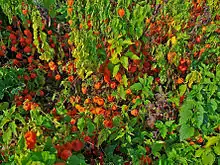Physalis alkekengi
Physalis alkekengi, the bladder cherry,[2] Chinese lantern,[3] Japanese-lantern,[4] strawberry groundcherry,[5] or winter cherry,[3] is a species of flowering plant in the nightshade family Solanaceae. It is a distant relative of the new world Physalis peruviana (Cape gooseberry). Unlike the rest of Physalis that is native to the Americas, this species is native to the regions covering Southern Europe to South Asia and Northeast Asia.
| Physalis alkekengi | |
|---|---|
 | |
| Physalis alkekengi fruit with the red husk | |
| Scientific classification | |
| Kingdom: | Plantae |
| Clade: | Tracheophytes |
| Clade: | Angiosperms |
| Clade: | Eudicots |
| Clade: | Asterids |
| Order: | Solanales |
| Family: | Solanaceae |
| Genus: | Physalis |
| Species: | P. alkekengi |
| Binomial name | |
| Physalis alkekengi | |
| Synonyms[1] | |
| |
Description
It is easily identifiable by the large, bright orange to red papery covering over its fruit, which resembles paper lanterns. It is a perennial herbaceous plant growing to 40–60 cm tall, with spirally arranged leaves 6–12 cm long and 4–9 cm broad. The flowers are white, with a five-lobed corolla 10–15 mm across, with an inflated basal calyx which matures into the papery orange fruit covering, 4–5 cm long and broad.
Cultivation


It is a popular ornamental plant, widely cultivated in temperate regions of the world, and very hardy to below −20 °C (−4 °F).[6] It can be invasive with its wide-spreading root system sending up new shoots some distance from where it was originally planted. In various places around the world, it has escaped from cultivation.[7]
In the United Kingdom it has been given the Royal Horticultural Society's Award of Garden Merit.[6][8]
Traditional uses
The dried fruit of P. alkekengi is called the golden flower in the Unani system of medicine, and used as a diuretic, antiseptic, liver corrective, and sedative.[9]
Chemical constituents
Like a number of other species in the genus Physalis, it contains a wide variety of physalins.[10][11][12] When isolated from the plant, these have antibacterial[13] and leishmanicidal[14][15] activities in vitro.
It also contains caffeic acid ethyl ester, 25,27-dehydro-physalin L, physalin D, and cuneataside E.[16]
Cultural significance

In Japan, its bright and lantern-like fruiting calyces form a traditional part of the Bon Festival as offerings intended to help guide the souls of the dead. A market devoted to it - hōzuki-ichi - is held every year on the 9th and 10th of July near the ancient Buddhist temple of Sensō-ji in Asakusa.
Fossil record
Physalis alkekengi seed fossils are known from Miocene of Siberia, Pliocene of Europe and Pleistocene of Germany.[17] Pollen grains of Physalis alkekengi have been found in early Pleistocene sediments in Ludham east of Wroxham, East Anglia.[18]
References
- The Plant List
- "Physalis alkekengi". Eppo.
- "Physalis alkekengi". Germplasm Resources Information Network (GRIN). Agricultural Research Service (ARS), United States Department of Agriculture (USDA). Retrieved 20 December 2017.
- "BSBI List 2007". Botanical Society of Britain and Ireland. Archived from the original (xls) on 25 January 2015. Retrieved 17 October 2014.
- "Physalis alkekengi". Natural Resources Conservation Service PLANTS Database. USDA. Retrieved 1 October 2015.
- "RHS Plantfinder - Physalis alkekengi". Retrieved 27 April 2018.
- "1. Physalis alkekengi Linnaeus". Flora of China.
- "AGM Plants - Ornamental" (PDF). Royal Horticultural Society. July 2017. p. 78. Retrieved 27 April 2018.
- Rasheed N.M.A., Shareef M.A., Ahmad M., Gupta V.C., Arfin S., Shamshad A.K. "HPTLC finger print profile of dried fruit of Physalis alkekengi Linn." Pharmacognosy Journal 2010 2:12 (464–469).
- Matsuura, T; Kawai, M; Makashima, R; Butsugan, Y (1970), "Structures of physalin A and physalin B, 13,14-seco-16,24-cyclo-steroids from Physalis alkekengi var. Francheti.", Journal of the Chemical Society, Perkin Transactions 1, 5 (5): 664–70, doi:10.1039/j39700000664, ISSN 0300-922X, PMID 5461642
- Qiu, L; Zhao, F; Jiang, Zh; Chen, Lx; Zhao, Q; Liu, Hx; Yao, Xs; Qiu, F (April 2008), "Steroids and flavonoids from Physalis alkekengi var. franchetii and their inhibitory effects on nitric oxide production.", Journal of Natural Products, 71 (4): 642–6, doi:10.1021/np700713r, PMID 18348534
- Kawai, M; Yamamoto, T; Makino, B; Yamamura, H; Araki, S; Butsugan, Y; Saito, K (2001), "The structure of physalin T from Physalis alkekengi var. franchetti.", Journal of Asian Natural Products Research, 3 (3): 199–205, doi:10.1080/10286020108041391, ISSN 1028-6020, PMID 11491395, S2CID 26532208
- Silva, M.T.G.; Simas, S.M.; Batista, T.G.; Cardarelli, P.; Tomassini, T.C.B. (2005). "Studies on antimicrobial activity, in vitro, of Physalis angulata L. (Solanaceae) fraction and physalin B bringing out the importance of assay determination". Memórias do Instituto Oswaldo Cruz. 100 (7): 779–82. doi:10.1590/s0074-02762005000700018. PMID 16410969.
- leishmanicidal Archived 15 May 2010 at the Wayback Machine
- Choudhary M.I., Yousaf S., Ahmed S., Samreen, Yasmeen K., Atta-ur-Rahmang "Antileishmanial physalins from Physalis minima" Chemistry and Biodiversity 2005 2:9 (1164-1173).
- YUAN Ye, XU Nan, BU Xian-kun, ZHAN Hong-li, ZHANG Meng-meng Chemical constituents of Physalis alkekengivar. franchetii (Ⅱ) "Chinese Traditional and Herbal Drugs" http://en.cnki.com.cn/Article_en/CJFDTOTAL-ZCYO201012005.htm (Liaoning University of Traditional Chinese Medicine, Dalian 116600, China).
- The Pliocene flora of Kholmech, south-eastern Belarus and its correlation with other Pliocene floras of Europe by Felix Yu. VELICHKEVICH and Ewa ZASTAWNIAK - Acta Palaeobot. 43(2): 137–259, 2003
- History of the British Flora: A Factual Basis for Phytogeography by Sir Harry Godwin, Cambridge University Press, first published 1956, second edition 1975, ISBN 9780521269414
External links
| Wikimedia Commons has media related to: |